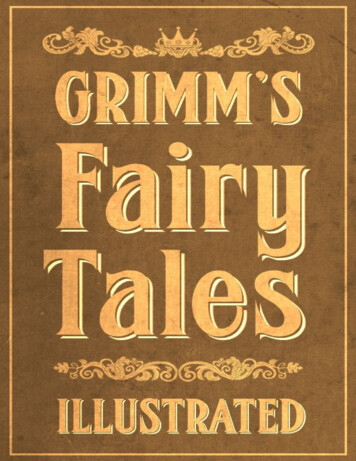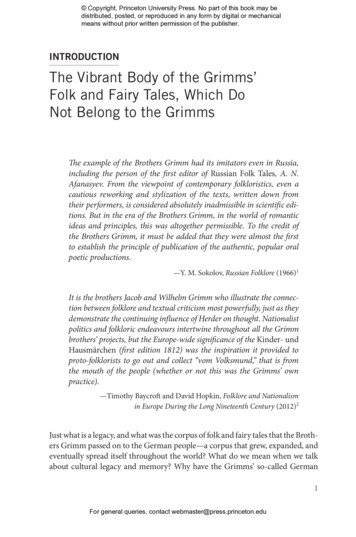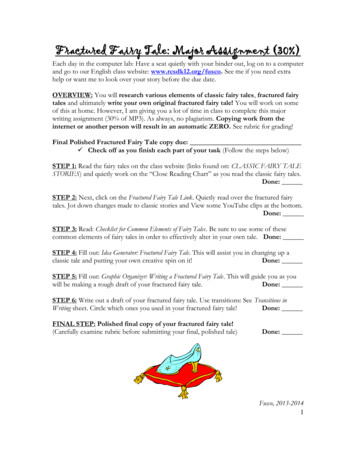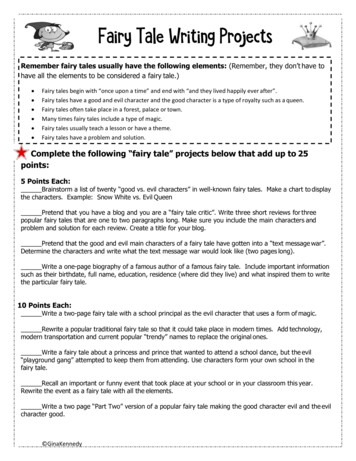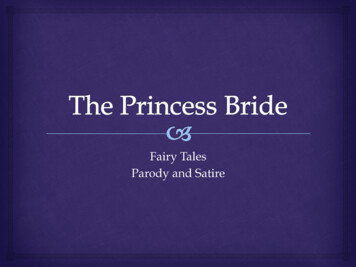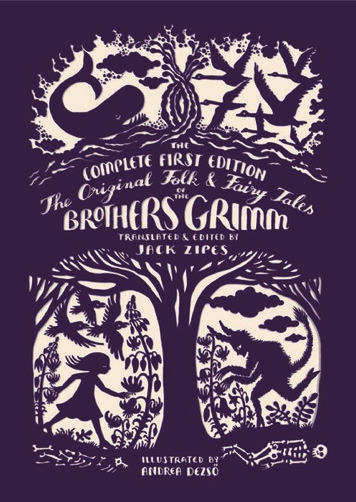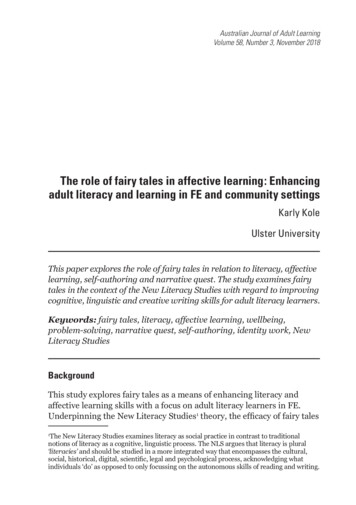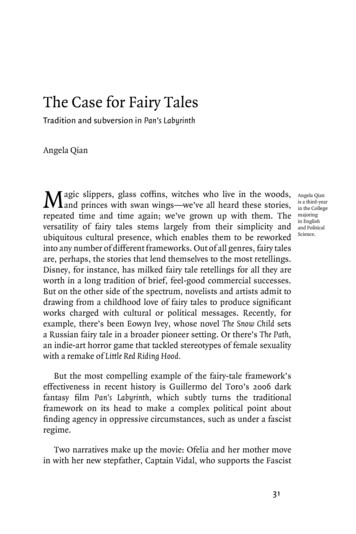
Transcription
The Case for Fairy TalesTradition and subversion in Pan’s LabyrinthAngela QianMagic slippers, glass coffins, witches who live in the woods,and princes with swan wings—we’ve all heard these stories,repeated time and time again; we’ve grown up with them. Theversatility of fairy tales stems largely from their simplicity andubiquitous cultural presence, which enables them to be reworkedinto any number of different frameworks. Out of all genres, fairy talesare, perhaps, the stories that lend themselves to the most retellings.Disney, for instance, has milked fairy tale retellings for all they areworth in a long tradition of brief, feel-good commercial successes.But on the other side of the spectrum, novelists and artists admit todrawing from a childhood love of fairy tales to produce significantworks charged with cultural or political messages. Recently, forexample, there’s been Eowyn Ivey, whose novel The Snow Child setsa Russian fairy tale in a broader pioneer setting. Or there’s The Path,an indie-art horror game that tackled stereotypes of female sexualitywith a remake of Little Red Riding Hood.But the most compelling example of the fairy-tale framework’seffectiveness in recent history is Guillermo del Toro’s 2006 darkfantasy film Pan’s Labyrinth, which subtly turns the traditionalframework on its head to make a complex political point aboutfinding agency in oppressive circumstances, such as under a fascistregime.Two narratives make up the movie: Ofelia and her mother movein with her new stepfather, Captain Vidal, who supports the Fascist31Angela Qianis a third-yearin the Collegemajoringin Englishand PoliticalScience.
the case for fairy talesregime in Spain and is fighting against insurgents who hide in theforest around his base. Ofelia’s mother, Carmen, is pregnant withCaptain Vidal’s son. Unhappy in her new home, Ofelia takes refuge ina magical labyrinth in the woods, where she meets a faun named Pan,who tells her that she is actually Princess Moanna of the Underworld,and that if she completes three tasks, at the full moon she will berestored to her true father, the King.1. JenniferOrme,“NarrativeDesire andDisobediencein Pan’sLabyrinth,”Marvels &Tales 24 (2010):220.2. LauraHubner, “Pan’sLabyrinth, Fearand the FairyTale,” At TheInterface/Probingthe Boundaries 61(2010): 50.3. Ibid., p. 52.The magical elements and parallelism to traditional fairy talesare obvious. The movie’s opening sequence begins with the wellrecognized fairy-tale words “A long time ago,” and when we firstsee Ofelia, in a car with her mother, she is carrying a book of fairytales. As critic Jennifer Orme points out, Ofelia’s appearance—herblack hair, pale skin, dress, and pinafore—reflects that of fairy-taleheroines such as Snow White or Dorothy of The Wizard of Oz.1 In asimilar vein, Laura Hubner notes that Ofelia sees her first fairy in thewoodlands, and it is in the woods that the fantastical elements ofOfelia’s story begin to play out.2 The symbolism of the wilderness isfamiliar from the journeys of characters like Hansel and Gretel, LittleRed Riding Hood, and Snow White. Like those characters, Ofeliamust also undertake an expedition into the wilderness to completeher three tasks. The number three itself is another fairy-tale tropeappearing in the film, along with that of the full moon as a bridgebetween the earthly and otherworldly, and—perhaps most obvious—that of an ordinary girl turned into a princess.Hubner argues that Pan’s Labyrinth has a “simple,” essentialistunderstanding of gender, citing Ofelia as the archetype of the goodand innocent girl and Captain Vidal as the two-dimensional evilvillain.3 But I would like to propose an alternate view: the process ofsubversion that allows for the disposal of the evil villain at the end ofthe film is a complex one. The process of undermining traditionalfairy tale tropes mirrors the overt rebellion against the Fascist regime,a dual process of subversion that allows Ofelia to choose to notparticipate in the Fascist world represented by Captain Vidal.32
angela qianUnlike feel-good fairy tales, Pan’s Labyrinth shows that magic doesnot provide a simple, happy answer to a story’s conflict. In boththe real world and the fantastical, the “right” answer is frequentlyambiguous; there is no clear-cut path. Like other fairy tale heroines,Ofelia receives a guide—the faun—who, like the traditional fairygodmother or wizened wise woman, is supposed to help her navigatethe pitfalls and strange logic of the magical realm. Ofelia first meetsthe faun at night, in the labyrinth in the forest where the rebels hide.But though he serves as a counterpoint to Ofelia’s unhappinesswith Vidal, the faun certainly does not seem to pose a safe or easyalternative. The faun’s appearance, like those of the fairies and otherfantastical creatures in the film, is eerie, even verging on grotesque.The tasks he sends her on—to go into the lair of a giant toad or thedungeon of a cannibalistic Pale Man with eyes for hands—are similarlygrotesque, and certainly dangerous. In this, the film clearly drawsupon the disturbing violence of the Brothers Grimm or older mythswith themes of blood sacrifice and dark magic, as opposed to theirsanitized Disney counterparts. The fantastical world is therefore nota means for Ofelia to escape; this realm is just as dark and dangerousas her reality, and fraught with potentialpitfalls and reversals of trust.The dangers of the fantasticalrealm parallel Ofelia’s struggleswith mentorhood in the realworld. Ofelia’s most obvious rolemodel—her mother—is, as istypical in fairy tales, largely out ofthe picture. Sickly and bedridden,Ofelia’s mother cannot effectmuch change; indeed, she hasmarried Captain Vidal and bornehis son in an effort to save herselfand her daughter, rather thanrebelling against the regime. Thiscreates a moral complication: we cannotexactly approve of Carmen’s decision to marry the cruelCaptain Vidal. She made this choice in what she thinks are the bestinterests for her family, but by submitting to Captain Vidal, Carmen33I succeededin extracting agrunt.
the case for fairy talesencourages an authoritarian regime and forces her and her daughterto conform to subdued, passive roles. The only role Carmen canserve, therefore, is that of a plot device, though the complexity of hermoral decisions reflects that of the choices Ofelia must make.4. Ibid., p. 53.Hubner points out that Pan’s Labyrinth alludes “to the actions offathers and forefathers here, troubling practices are transferredonto the evil stepfather” as opposed to the trope of the evil stepmotherfound in stories like Cinderella or Hansel and Gretel.4 In those stories, theabsent father allows for the degradation of his children; his crimeis incompetence and obliviousness. Here, however, Carmen is theone absent, and Vidal in all his cruelty is very much present. Carmen,submissive to Vidal, cannot actively protect her daughter or unbornson; she can no longer act as a mother or a role model. Moreover, wesee that Ofelia and her mother do not understand each other, despitetheir love. When Carmen gives Ofelia a dress, Ofelia is not enthused;she wants books while her mother wants her to stop reading fairytales and get a hold of reality. Carmen wants Ofelia to accept hersurroundings and try to live as comfortably as she can through Vidal’s34
angela qiansystem. Ultimately, however, Carmen dies—giving birth to the sonVidal has always wanted, who will inherit his name.Why would del Toro choose to reverse the gender roles of thestepparent and parent here, in a narrative set during a time of overtpatriarchal family structures when women like Carmen were relegatedto restrictive stay-at-home-wife roles? This is one example of how hetwists the traditional fairy-tale narrative to illustrate a political pointabout gender hierarchies. Vidal, the father figure, actively createsoppression rather than passively letting it happen. But, in a crucialreversal of traditional tropes, Ofelia does not try to get out of hersituation by trying to emphasize her feminine desirability.A frequent contemporary critique of traditional fairy tales is thatthe heroines are saved or rescued from their situations by princes;therefore all their happiness and success is dependent on beingmarried off, bearing children, and living happily ever after. Pan’sLabyrinth takes this narrative in a different direction. It shows withCarmen’s case that marriage often does not end happily. Ratherthan emphasizing the fairy-tale heroine’s sexual desirability, Pan’sLabyrinth shifts the focus to parenting (or the lack thereof); the moraltakeaway of the narrative is therefore allowed a much broader scope.Instead of a knight or young farmer boy going on a quest tocomplete three tasks to save a princess, it is the princess herselfwho must go on a journey. In fact, the story of Princess Moannafocuses not on a romantic arc but on her attempt to be reunited withher parents. Indeed, the story takes the child of the fairy tale andtransforms her: more than a mere journey through space, her journeybecomes a psychological journey towards adulthood.Without her mother as an active role model for Ofelia, the narrativehas room for a new maternal mentor. Captain Vidal’s householdturns up Mercedes, a female servant who steps into the empty spaceof Ofelia’s maternal guide—singing her lullabies, telling her aboutfairy tales, and including Ofelia in the secret rebellion against Vidal.Mercedes serves as a sharp contrast to Carmen. Unlike Carmen,who, exasperated, tells Ofelia she must stop believing in fairy tales no35
the case for fairy tales5. Ibid., p. 50.matter how much it hurts, Mercedes does not refute Ofelia’s belief.Mercedes plays the role of a native—someone of the land who knowsthe myths and legends as well as she knows the woods. It is she whofinds Ofelia coming out of the woods after her first encounter withthe toad, and she who goes into the woods to signal to the rebels.We are reminded again of Hubner’s point, that the rebellion takesplace in the woodlands, the locus of the magic.5 On the otherhand, Vidal and Carmen’s aversion to the woods marks themas intruders. The woods intimidate Vidal, and thus he loseshis advantage there. Similarly, Vidal cannot make sense of orcontrol magic, and therefore refutes it, as in the scene wherehe throws the mandrake root into the fire.Carmen never leaves the house and isangry at Ofelia for getting her dress dirtywhile in the woods. These characters,unlike Mercedes, do not know how totread the line between mysticism andreality.And of course, Mercedes is partof the insurgent movement seekingto dispose Vidal. It is because Ofeliahas Mercedes that she understandsanother option is presented to her,one intuitively more satisfying than Carmen’s choice infollowing Vidal, and the route she ultimately takes: rebellion.Beatthybelly,then,and wagthy ears.In traditional fairy tales, growing up is usually glossed over quickly;character development falls to the wayside in favor of magicalobstacles and tasks. In Cinderella, for instance, Cinderella doesn’t needto grow up—all she needs is to have her goodness recognized via theglass slipper. Snow White never needs to learn to say no to suspiciousold women selling apples and corsets; the plot will carry her through.But this reliance on deus ex machina leaves little room forcompelling characters. Ofelia does have to grow up, and when shedoes, she no longer lets the fairy tale control her. This twist in the36
angela qiantraditional framework allows del Toro to make a much larger politicalcommentary on how a heroine might take control over the forces ofa fantastical plot (and in del Toro’s case, fascist Spain) seeking toshape her path. Ofelia’s divergence from the norms of the fairy talesshe herself admires reflects her departure from what is expected ofher; we see her ability to deviate from the fairy-tale narrative offeredto her in her rejection of Captain Vidal and his authoritarian rule.Pan’s Labyrinth uses Ofelia’s individual choices as a springboard intothe broader implications of how one might question, criticize, andrebel against restraints and expectations.Having listened to the faun’s instructions for the majority of thefilm, Ofelia follows a path that theoretically should take her back tothe Underworld. At the climax of the film, Captain Vidal, who hasbeen surprised by an attack from the insurgents, chases Ofelia andher baby brother into the labyrinth. At the portal to the Underworld,the faun asks Ofelia for the blood of an innocent: just a little blood,he asks, from her baby brother.But Ofelia says no. The faun, in disbelief, asks if she will giveup her right to return to the Underworld for this child; Ofelia againrefuses to give him up. Meanwhile, Vidal has followed her into thelabyrinth. He only sees Ofelia talking to empty air. He aims a gunat her and asks her to return his son to him. When she refuses, heshoots her. Ofelia falls, dying; it is her innocent blood that is shed.Though the movie ends with a shot of her standing in front of herroyal parents in the Underworld, del Toro leaves it up to us whetheror not this fairy-tale ending actually happens.Ofelia’s death at the end of the movie completes a coterie ofimages tied to blood throughout the film. Richard Lindsay has notedthe widespread use of uterine imagery and bloodletting throughoutthe film to argue that Ofelia’s journey is one familiar to mostwomen—that of initiation into womanhood, a passage marked bya girl’s first period.6 For instance, the very opening shot of the filmshows Ofelia lying with blood on her face; the red stands in vividcontrast to a palette otherwise subdued by hues of blue and gray. Thisis the first hint we receive of the importance of blood—both literaland figurative—throughout the narrative. When Carmen begins376. RichardLindsay,“Menstruationas Heroine’sJourney in Pan’sLabyrinth,”Journal ofReligion and Film16 (2012): 3.
the case for fairy talesto bleed as she is about to give birth, Ofelia sees the spreading ofblood through the magical book the faun has given her. Del Toro hasadmitted the tree the bloated toad lives in intentionally parallels theshape of the ovaries, a feminine image; the chamber Ofelia finds thetoad in looks like a womb. And the final task asked of Ofelia is for theblood sacrifice of an innocent, of her baby half-brother.What work does creating these implicit connections betweenOfelia’s girlhood and her navigation of the real and fantastical worldsdo? Lindsay argues that it is an usurpation of the traditional heroicnarrative:The tradition of blood sacrifice used in religion, includingthe Christian cycle of crucifixion and resurrection, comesin part from the attempt of men to create a ‘pure’ that is,non-female, form of bloodletting that has the same powerover life and death as the bloodletting of menstruationand birthing The hero’s journey thus represents the bloodsacrifice of the male warrior, a descent into death, and aresurrection into semi-divinity without the spiritually‘tainted’ blood of a woman. In appropriating the hero’sjourney as a metaphor for female menstruation, therefore,del Toro transgresses the patriarchal cycle of womanlessregeneration.77. Ibid., p. 7.Traditionally, blood sacrifices come from innocent women—thatis, virgin girls. The faun, however, makes no such demand; indeed,the faun first asks for the blood of Ofelia’s younger brother. ThoughOfelia herself becomes the sacrifice, this decision is hers. She decidesto protect her younger brother, and, in taking his place, wins passageto the Underworld.Ofelia’s choice is the culmination of her growth throughout thefilm. In allowing her blood to be shed, she is, for the first time, takingpart in bloodletting. This could be read symbolically as a stand-in forher first period, but even if we do not take such a reading, we can seehow the choice is symbolic of Ofelia becoming an active shaper of38
angela qianher own narrative. It is the first moment in which Ofelia has outrightdefied the rules she has been told to follow.She has disobeyed the faun, a symbol of the magic world; she hasdefied Vidal, who asks her to return his son. Meanwhile, her mother,Carmen, is dead, and she gives up hope of returning to any magicalparents in her decision to not give the baby to the faun. In protectingthe child, she has assumed an agency in her narrative that is sharedby one other female character—Mercedes. By this act of defiance,Ofelia has completed the arc of subversion of the traditional fairy talenarrative and stepped into the active maternal role herself. At the endof the fairy tale and the film, therefore, Princess Moanna returns tothe Underworld and rules.39
the case for fairy talesIf we look at Pan’s Labyrinth in this way, the film becomes remarkablefor its take on what could have easily become either a generichistorical drama or a simplistic fairy tale retelling. Del Toro’s geniuslies in how he not only makes the fairy-tale framework the mostaccessible point into a historical conflict that some viewers otherwisemay have difficulty relating to, but also in how he does not let the fairytale overpower the political or moral takeaways (or vice versa). Evenat the end of the film, the viewer remains unsure whether the magicwas real at all, whether Ofelia died and went to the Underworld, orwhether she died and the fairy tale is merely a last dream. Del Toroleaves us with this ambiguity, letting us, like Ofelia, make our ownchoices as to what to believe. The power of Pan’s Labyrinth lies in thismeeting of maturity and childhood nostalgia, of hard reality and ouryearning to believe in magic. Del Toro is able to renew the timelessrelevance of fairy-tale tropes in his film, but also go a step beyond thatand show us, in his masterful execution, how such classic stories canbe refashioned into a new breed.40
Disney, for instance, has milked fairy tale retellings for all they are worth in a long tradition of brief, feel-good commercial successes. But on the other side of the spectrum, novelists and artists admit to drawing from a childhood love of fairy tales to produce significant works charged with cultural or political messages. Recently, for

